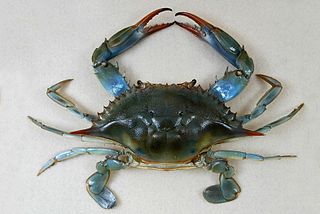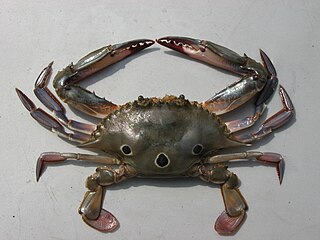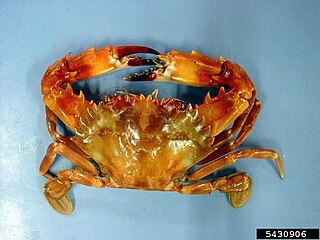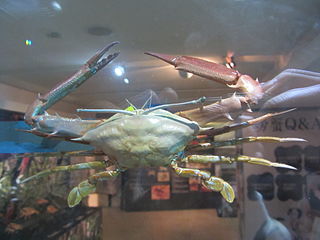
Callinectes sapidus, the blue crab, Atlantic blue crab, or regionally as the Chesapeake blue crab, is a species of crab native to the waters of the western Atlantic Ocean and the Gulf of Mexico, and introduced internationally.

The Florida stone crab is a crab found in the western North Atlantic, from Connecticut to Colombia, including Texas, the Gulf of Mexico, Belize, Mexico Jamaica, Cuba, The Bahamas, and the East Coast of the United States. The crab can also be found in and around the salt marshes of South Carolina and Georgia. It is widely caught for food. The closely related species Menippe adina is sometimes considered a subspecies – they can interbreed, forming hybrids – and they are treated as one species for commercial fishing, with their ranges partly overlapping. The two species are believed to have diverged approximately 3 million years ago.

Portunus pelagicus, also known as the flower crab, blue crab, blue swimmer crab, blue manna crab or sand crab, rajungan in Indonesian, and alimasag in Tagalog, Kapampangan, and Pangasinan, is a large crab found in the intertidal estuaries around most of Australia and east to New Caledonia.

Portunus trituberculatus, the gazami crab, South Korea's blue crab or horse crab, is the most widely fished species of crab in the world. It is found off the coasts of East Asia and is closely related to Portunus armatus.

Charybdis is a genus of swimming crabs in the family Portunidae; "Charybdis" is Greek for whirlpool.

The Peel-Harvey Estuarine System is a natural estuarine system that lies roughly parallel to the coast of Western Australia and south of the town of Mandurah.

Ovalipes catharus, commonly known as paddle crab and Māori: pāpaka, is a species of crab of the family Portunidae. It is found around the coasts of New Zealand, the Chatham Islands, and in south-eastern parts of Australia. Individuals from shallow waters, 0.1–0.5 metres (4–20 in) deep, have a carapace width of only 10–15 millimetres (0.4–0.6 in), while those from 5–15 m (16–49 ft) are 100–140 mm (3.9–5.5 in) wide.

Crab fisheries are fisheries which capture or farm crabs. True crabs make up 20% of all crustaceans caught and farmed worldwide, with about 1.4 million tonnes being consumed annually. The horse crab, Portunus trituberculatus, accounts for one quarter of that total. Other important species include flower crabs, snow crabs (Chionoecetes), blue crabs, edible or brown crabs, Dungeness crab, and mud crabs, each of which provides more than 20,000 tonnes annually.

Callinectes similis, sometimes called the lesser blue crab or dwarf crab, is a West Atlantic species of blue crab. It was described by Austin B. Williams in 1966.

Coastal fish, also called inshore fish or neritic fish, inhabit the sea between the shoreline and the edge of the continental shelf. Since the continental shelf is usually less than 200 metres (660 ft) deep, it follows that pelagic coastal fish are generally epipelagic fish, inhabiting the sunlit epipelagic zone. Coastal fish can be contrasted with oceanic fish or offshore fish, which inhabit the deep seas beyond the continental shelves.

Alpheus heterochaelis, the bigclaw snapping shrimp, is a snapper or pistol shrimp in the family Alpheidae. It is found in the western Atlantic Ocean and the Gulf of Mexico.

Portunus sayi, the sargassum swimming crab, is a species of pelagic crab in the family Portunidae. It is found in the western Atlantic Ocean and the Caribbean Sea where it makes its home among floating mats of Sargassum seaweed. It was named in honour of the American naturalist Thomas Say.

Moreiradromia antillensis is a species of decapods in the family sponge crab. This species lives in the Western and central Atlantic Ocean.

Portunus sanguinolentus, the three-spot swimming crab, blood-spotted swimming crab or red-spotted swimming crab, is a large crab found throughout estuaries of the Indian and West Pacific Oceanic countries.

Charybdis hellerii, the Indo-Pacific swimming crab or spiny hands is a species of crab from the swimming crab family, the Portunidae. Its native range covers the Indian and Pacific Oceans but it has been introduced to the western Atlantic and has invaded the Mediterranean. It is a commercially exploited species in south-east Asia.
Charybdis longicollis, the lesser swimming crab, is a species of crab from the swimming crab family, the Portunidae. It has a native range which covers the north-western Indian Ocean and it has invaded the Mediterranean Sea by Lessepsian migration through the Suez Canal.

Portunus segnis, the African blue swimming crab, is a species of crustacean, a swimming crab belonging to the family Portunidae. While native to the western Indian Ocean, it is also invasive in the Mediterranean. It is thought to have come through the Suez Canal from the Red Sea but it may have been transported by ships.

Podophthalmus vigil is a species of swimmer crab found in tropical areas of the Indo-Pacific Ocean, including Hawaii, Japan, South Africa, the Red Sea, Australia. In Australia the crab is found across the north from Exmouth to Moreton Bay. It is commonly known as the Long-eyed swimmer crab Stalk-eyed swimmer crab, Red crab, or Periscope crab. Like other swimmer crabs the last pair of legs have flattened ends to form paddles. Colors include a greenish brown carapace with possible red spots, claws and legs pale violet, rose red or dark red. The carapace is typically up to 100mm across, very broad at the front, narrow at the back with a spine on each side. There is a single tooth behind the spine. Males are larger than females and have more elongated limbs.

Macrophthalmus crassipes is a species of sentinel crab in the family Macrophthalmidae, found around China, Thailand, Malaysia, Australia, and the Caroline Islands. In Australia it is found from north Western Australia through to New South Wales. Common names include the seagrass sentinel crab and the orange spined sentinel crab. On adult males there is a substantial tooth on the lower claw and a much smaller tooth on the upper claw, and noticeable orange spines on the “wrist” (carpus) of the clawed leg and on the palm of the clawed leg. The carapace is covered in small granules, and is up to around 37 mm (1.5 in) across. It is a burrowing crab, and lives in open tidal flats, muddy or with sandy mud, low on tidal creek banks, and adjacent mangroves.

Tubuca coarctata is a species of fiddler crab found in the western Pacific ocean, including Japan, Taiwan, the Philippines, Indonesia, New Guinea and Australia. The common name of these crabs is either the compressed fiddler crab, or the orange-clawed fiddler crab,. They are found on tidal mud flats adjacent mangroves and muddy tidal creek and river banks.


















